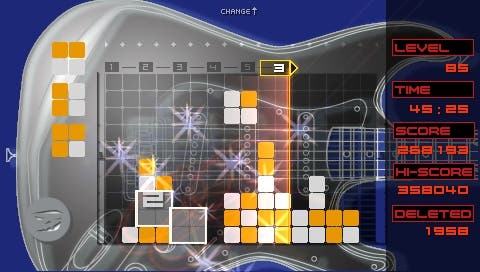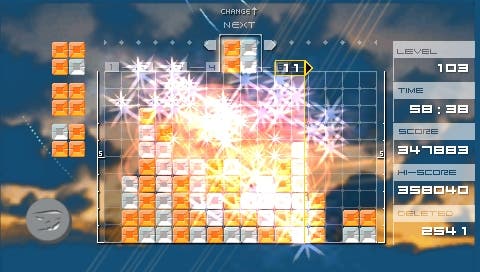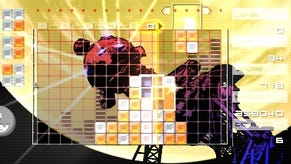Lumines
Why are we still playing it nearly a year later?
We've already reviewed Lumines. We did so just after its Japanese release last December. Our view now is very much the same. In fact, all we really need to do here is change some of the names (Ubisoft distributes the game here, not Bandai) and mention that some of the glitches have been fixed (you no longer lose your final score if you turn off the PSP and then resume a game later, for example) and that we're adding another point on that basis. How, then, can we justify spending more time writing about it? Surely anything else is parenthetical at best.
Well, no.
Most of us here at Eurogamer bought Lumines on the same day we bought our Japanese PSPs about nine months ago. We're still playing it.
Now, reviewers say that kind of thing all the time. "We can't believe we're still playing it blah blah buy it." So let's instead consider just how awesome a statement that actually is, and why it's valid.
In the time since we started playing Lumines, we've enjoyed whirlwind romances with several other puzzle games. First there was Zoo Keeper on the DS, an almost perfectly measured grafting of stylus controls onto tile-shifting classic Bejeweled. Then there was Meteos, another DS title - from the same studio as Lumines in fact - which bound itself to our styli in a manner that helped dispense with an entire transatlantic flight. In fact, when we regrouped back in Blighty and made new industry friends a few weeks later, it formed the basis of at least one anecdote along the lines of, "Oh yes, I remember - you were the geeks next to the window who didn't look up from your games for an entire timezone."
Wonderful though those games were, we hit a ceiling with both.
In the case of Zoo Keeper, we simply couldn't top up the timer after a certain point. Patterns were there, but its demands were becoming unrealistic. Comboing became a question of moving the panda, waiting for the lion to drop down before sliding its friend into the right position, then moving to the bottom of the screen to get rid of the giraffes and lower the other lion, which in turn helped line up two of the three necessary elephants, the third of which... Well, where was he? Half the time, we were under such pressure that we didn't even spot the first panda.

Meteos was much the same for different reasons. Creating lines of blocks and blasting them into space was great fun, and the huge variation in level conditions meant that it enjoyed far more time in our DS slots than it would have otherwise. But precise stylus movement was frustratingly hard with so many blocks moving in different directions at different points on the screen; panicking in the face of seemingly unsolvable lines made it even more difficult to react quickly and accurately; and ultimately we were trampled into the ground by a downpour of new blocks anyway.
Don't get us wrong; we'll happily play Zoo Keeper and Meteos all day long. We can talk about them for hours. We've probably spent more time on those two together than some of us have spent in the pub all year - and, judging by some recent forum threads, all we ever do is spend time in the pub. If you asked us now what we'd rather play though - Zoo Keeper, Meteos or Lumines - the answer would almost certainly be Lumines.
(Uh. Some of you are now typing, "Apparently the way you can justify talking about Lumines again is by not mentioning it for a page and a half." Leave iiiiiit.)
Lumines, then. Blocks fall from the top of the screen into a rectangular play area (which, it won't have escaped your attention, is lying on its side), and you have to create little groups of the same colour to make them disappear. There are two colours, blocks descend in little squares of four - helpfully mixed up so that you have multiple patterns to consider - and it's not just squares that disappear. You can arrange squares that overlap, rectangles and other shapes - the basic rule being that if a block has three same-coloured blocks wrapped around one of its corners, it's disappearing. If those blocks happen to have the same going on at the opposite corner, they go too.
"How do these blocks disappear?" you're wondering. Simple: a vertical line sweeps from left to right and wipes away any appropriate groups. Any blocks on top of them then fall down to fill the gaps, and so on.
There are other things to consider too. Jewel blocks, for example. These appear every so often, and, if they're arranged in a square that's about to be wiped away, they'll tag any and all blocks that can be linked to them in a solid line of the same colour. If you're clever, you can use them to wipe every single block of a certain colour off the screen, which gets you a big bonus. Clearing the entire screen gets you an even bigger one. Using jewel blocks properly is a bit like an advanced take on leaving an empty column at the side of the screen in Tetris. Similar discipline; similarly risky; but much harder to do.

But Lumines is much smarter than that. The reason we're still playing it isn't that it came from a good idea; it's that it took that good idea and built a brilliant game out of it. If it were like Zoo Keeper or Meteos - or even Tetris - it would just force you to react to the falling blocks faster and faster. Lumines works slightly differently. A bit like Meteos, it has lots of different levels that change the play conditions, and it calls these "skins". Each skin varies the design of the blocks, which can make things more difficult anyway, but more importantly it varies the pace of the sweeping line.
You might find things disappear quickly one moment, and the next the sweeping line takes an absolute age to cross the screen. If you've got lots to deal with already and you're running out of headroom, this can be a nightmare. But if you've got a jewel piece in there somewhere on the left, it can leave you with enough time to slot more blocks into place and link the jewel to others further to the right of the screen. Whereas Meteos separated the various levels out, Lumines gives them to you in a continuous, undulating, condition-shifting burst. Later on, the pace of the falling blocks changes too.
And that's to say nothing of the aesthetic qualities of the skins. Each is matched to a piece of music, and, in much the same way that Meteos and Dreamcast/PS2 classic Rez bound gameplay to audio, what you do with the blocks is reflected in the noises the game makes. It's all Japanese electronica, so you might call it an acquired taste; the joy is that you don't really need to acquire it for Lumines to dominate your life. Some might disagree, but, for this reviewer, it's just something you can enjoy.
Of course, the most obvious challenge in Lumines is rotating the falling patterns so that they wrap round whatever you've already got and form squares. The whole game falls down (or rather doesn't, which is worse) if you can't figure out the patterns. And it seems likely that some people won't. We can forgive it that, though, because it's impossibly hard for a developer to judge the difficulty curve on something like this - and from our perspective Lumines hits enough of a sweet spot.
Initially, you'll just create squares opportunistically. Presented with a couple of opposing L-shapes, you'll dump them to the ground and watch the square in the centre disappear. Give it a bit of time though and you'll spot something. Maybe you'll start dumping L-shapes on top of single blocks, so that the upright part of the L slides down and creates a square. Maybe you'll start paying more attention to the left side of the screen, which shows you the make-up of the next few falling squares, and use that to your advantage. However you learn it, the point is that you do. You simply get better at spotting patterns. There's conscious effort there, but a lot of it is subconscious too. Given enough play, you can even learn to anticipate the next skin and the advantages it'll give you.

All of this is why we're still playing Lumines nine months later. There's also a wireless mode, an against-the-CPU mode, single-skin modes, timed modes, and a puzzle mode that has you trying to create certain patterns out of the blocks. The latter, by the way, is a useful way of training your brain to spot certain patterns. What's more, if you're sitting there thinking that you'd probably rather not spend an hour at a time playing it, these modes are for you.
That said, apart from puzzle mode, this reviewer has spent more or less all of his time on the main single-player challenge mode. And that's a lot of time. So then: given that; given the sheer artistry of the design, both technically and aesthetically; given that we've just said it's our favourite puzzle game of the year; and given that we have actually played it all year, we felt it deserved another write-up.
To put it another way: this is a genre that demands brilliance of concept and execution, variation in play conditions, subtlety of design and careful management of the endgame, and while most of the best-rated puzzle games come close in a few areas, Lumines sweeps across the lot.
Lumines is released in Europe on September 1st.





